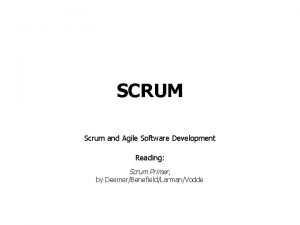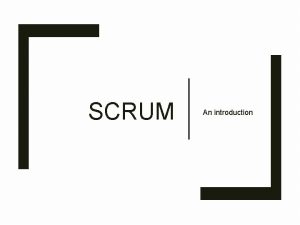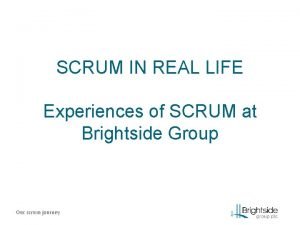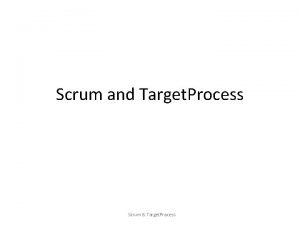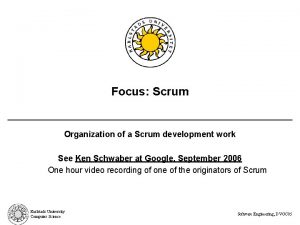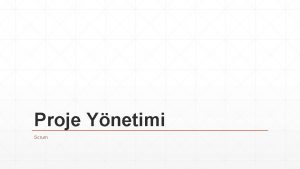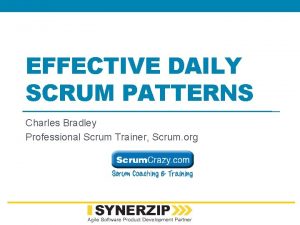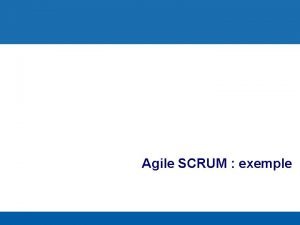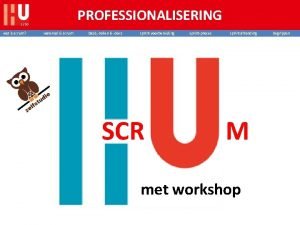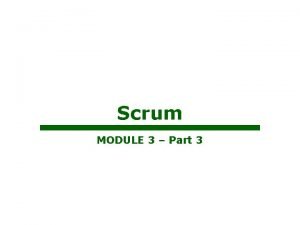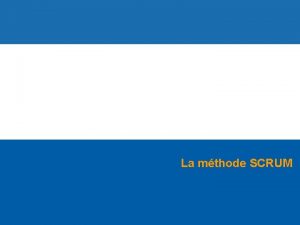A Day in the Life of a Scrum





























- Slides: 29

A Day in the Life of a Scrum Master (Agile Facilitator)

Learning Objectives and Agenda • Create a base understanding of the Agile roles, activities, and clarify any questions. • Learn techniques for handling common scenarios. • Have fun and meet people in your Agile community. • Agenda: – (icebreaker) – not included in deck – Quick Review of Roles to ensure Common Terminology – Match Up – Scenarios: What should you do? UPDATE: Due to time constraints this will be a separate session • Assumption: Audience has at least basic understanding of Agile through attending the Agile Bootcamp or Foundations class

Review 3

Importance of defining Roles • Roles are defined to set expectations between those working on and with the team • Defining Responsibilities enables alignment so that expectations can be identified and misses can be resolved • Being explicit on who will do each Role and what that means builds trust within the team once those are done – skipping this step tends to lead to something being dropped and resentment building because of misalignment • How to do this with your team: – Establish common Role name and definition of responsibilities throughout process – Identify by name who will fill this role – Review if there any conflicts (ex. Agile Facilitator and Product Owner) or gaps – Adjust as needed 4

Agile Planning Practices • This Practice has multiple cooperative and co-enhancing levels, sometimes also called the Planning Onion – Enables alignment between daily work and vision – Enhances visibility if there is a disconnect • The process has a rhythm of activities on a regular cycle called a Cadence – Allows team to focus on work not logistics of when a new meeting should be scheduled – Provides easy measurement between cycles and easy alignment across teams, projects, etc. Strategic Vision Roadmap Release Sprint Daily Tactical 8

Agile Planning Paradigm Shift Scope Time Traditional Limit Scope change Time and Cost may vary if Scope is larger than expected Time Cost Scope Agile Control Time and Cost Scope may change based on feedback and / or each update of the system 6

Being an Agile Team – start with being a “Team” • Every team (Agile or otherwise), cycles through these stages… – Forming, Storming, Norming and Performing • Awareness of this enables more realistic expectations regarding… – Ability / pace in which a Team (and their organization) can adapt to change – And what it will look like at the Team Level 9 Source: Bruce Tuckman, https: //topazsmartd. wordpress. com/page/18/

Team and Community – the Conversation • Agile continually fosters Conversations – Due to the pervasive presence of Feedback Loops built into Agile • These conversations create transparency which results in… – Alignment opportunities – Feedback opportunities – Expectation management being built in – Numerous opportunities to reveal what reality actual is – Leveraging and improving the shared Agile “language” • In order to better enable articulation around alignment • Agile Values, Principles, Practices, Activities, Roles, Artifacts and Terminology – Continuous Improvement opportunities 11

The Agile Roles • User(s) & Stakeholder(s) – Defines what value is being asked to be delivered User(s) & Stakeholder(s) • Product Owner(s) – Represents all Users & Stakeholders whose User Stories are on an Agile Teams Backlog – Abbreviated as PO • Team Members – Cross functional creators and sustainers of the solution • Agile Manager(s) – Organizational and Continuous Improvement activities Agile Manager(s) PO(s) – Reporting, Team and Project Managers • Agile Facilitator(s) – Agile Coach, Scrum Master (SM), Kanban Coach, Test-Driven-Development Advisor etc. Agile Team Members Agile Facilitator(s) • Agile Team – Team Members + PO(s) + Agile Facilitator(s) 19

Agile Match Up 10

Role and Behaviors: Agile Match Up • Form “teams” around each table 5 -7 people • Your “team”(table) will be assigned a ceremony, given flip chart paper and a stack of behaviors 1. Introduce yourselves to other teach members 2. Match the behavior to the Role performing that behavior 3. Identify who will introduce you to the rest of the room and who will read out what you Matched Up! 4. We will go around the room - 20 min for all tables to present – Present your Match Up – Audience – do you agree? 11

UPDATE: Key Takeaways • Many responsibilities could be done by different people, there is not necessarily a “right” answer ØEvery team should explicitly define which responsibility will be done by which role UPDATE: In the Match Up slides • Role we had planned to be matched is “Proposed” and matches from the event are “Event” • Agile Facilitator (Scrum Master) is noted as Agile Facilitator • Agile Facilitator role is as a Servant Leader, tasked with enabling Team to function well – Many behaviors could be Team Member or Agile Faciltator depending on how consistently team performs them • Some roles have a conflict of interest: – Product Owner and Agile Facilitator: • PO would like everything in the backlog done • Agile Facilitator focuses team having a sustainable pace and effectiveness of process, including PO’s role – Agile Manager – Reporting Manager and Team Member: • Team Members should work without a hierarchy, a challenge if there is a HR Reporting hierarchy 12

Daily Planning Responsibility Proposed Event Discuss plans for today: What you will on, and update anything completed yesterday Team Member Same Identify anything going slower than planned (blocked), who/what is blocking – solution discussion after daily plan Team Member Agile Facilitator Listen to other team members to adjust your plans or give input so that the team accomplishes goals together Team Member Compare progress against sprint goals – is a team member starting a new story when one is in progress that they could work on to get to done? Team Member Agile Facilitator Define and Assign Tasks to Team Members – Pull tasks to “In Progress” and label tasks to indicate you are working on it Team Member Same Note any tasks that seem stuck in progress or question updates that seem confusing, such as “I am still working on task 123456” Agile Facilitator Team Member Note any impediments noted during Daily planning for solutioning after Agile Facilitator Agile Manager Discuss with team any impediments that the team is unable to resolve and who it should be handed off to, often an Agile Manager Agile Facilitator Agile Manager Coach the team when behaviors to align with Agile values, adjust if not align and highlighting if in alignment Agile Facilitator same Start and facilitate daily planning Agile Facilitator Optional attendant, since primary focus is on external governance (be mindful of team members time – look to align per the team’s cadence) Agile Manager – PM User/ Stakeholder 13

Sprint Planning Responsibility Proposed Event Plan what user stories will be completed within the defined timeframe of a sprint or release Team Member Product Owner Break each user story into the tasks that need to be completed to meet Definition of Done for the team Team Member same Adjust capacity with anything that will impact your ability to get work done this sprint, ex. Vacation, training, a different project close Team Member Agile Facilitator Assess if the sprint plan is realistic based on user stories included versus the team’s velocity and capacity Team Member Agile Facilitator Confirm and make visible to stakeholders what is expected to be completed Product Owner by the end of this sprint or defined time same Clarify any questions about what the users need and why, particularly Acceptance Criteria Product Owner same Facilitate the Meeting Agile Facilitator same Ensure planning continues until the plan is realistic and agreed to by team members Agile Facilitator same Ensure the Team has all of the things they need prior to meeting – list of potential user stories, capacity, velocity Agile Facilitator same Lead team through reviewing that all tasks are included to meet Do. D Agile Facilitator Team Member Last opportunity to identify any items that may impact team or individual capacity, ex. Working with another team, roll-out, personal development Agile Manager Agile Facilitator 14

Release Planning Responsibility Proposed Event Identifies Minimal Viable Product (minimum) Features Product Owner same Identifies critical Milestone dates Product Owner User/ Stakeholder Work with Agile Manager to identify any additional stories to mitigate risks Product Owner Agile Facilitator Monitors progress and highlights if adjustments are needed Agile Manager. PM Agile Facilitator Slot Features based on Milestones, Market need, and Velocity – confirm with team and Product Owner Agile Manager. PM same Agree that the plan seems reasonable and there are no questions or confusion on the goal Team Member same Identify dependencies across teams, departments, events, purchases, etc. Team Member Agile Manager. PM Estimate all activities in hours Team Member same Agree that there are no changes to staffing on the team that would impact plans Agile Manager – Reporting Manager same Establish average velocity to be used to extrapolate roughly what should be able to get done Agile Facilitator Team Member Size work into rough estimates 15

Backlog/Queue Refinement Responsibility Proposed Event Order backlog to reflect greatest value to users Product Owner same Clarify anything that seems off from expectations-design discussion that miss needs, wildly different size than expected (team owns size, but sometimes ask is miscommunicated leading to missed size) Product Owner Agile Facilitator Answers Team questions in session or take away to research and answer next session Product Owner same Understand all of the backlog items – ask questions Team Members same Understand each story enough to have a reasonable idea of what needs to be done Team Members same Create a first pass of estimates that can be taken to the team Size work to be able to complete each Work Item per the Team’s Definition of Done (Do. D) Team Members same Refine backlog by working from top to bottom – review user stories iif changes are needed (size, order, etc), discuss any new stories Team Members and Product Owner any Identify Technical Work Items with their described value that are needed to manage technical risks or remove technical debt Team Members any Sets timing and details for establishing team cadence and where refinement fits Agile Facilitator Team Member Facilitate refinement workshop Agile Facilitator any Updates work items to reflect discussions any 16

Sprint Review Responsibility Proposed Event Demo any work completed in order to solicit feedback Team Member same Review what was planned, what was completed and what was not Team Member Product Owner Identifies any process changes and reviews any team indicators Team Member Agile Facilitator – SM Captures feedback from stakeholders and users to have functions adjusted Agile Facilitator – SM Product Owner Preview plans to confirm alignment Agile Facilitator – SM Agile Manager PM Captures any new requests to be added to the backlog during next refinement session Product Owner Agile Facilitator – SM Attends review to see what team is working on and stakeholders reactions Agile Manager same Attends Reviews to see what new features have been developed and give feedback (positive or negative) User/ Stakeholder same 17

Retrospective Responsibility Proposed Event Facilitates Retrospective session Agile Facilitator same Capture what the team has identified as the Action Item and add to next sprint to be treated as a story Agile Facilitator same Ensure that the people identified to attend by the Team are invited and attend Retro; explain to any uninvited guests the process Agile Facilitator same Openly discuss issues and identify experiments to improve or build upon identified challenge Team Member same Attend only if invited Product Owner and Agile Manager Product Owner and User/Stakeho lder Add the action items to be ordered in backlog Product Owner same Receive experiments that the team wants but is outside their control Agile Manager same 18

Status Reporting Responsibility Proposed Event Update tasks with remaining time if that is team process Team Member same Ensure that work items are visible and status is easily determined off board Team Member Agile Manager – Reporting Manager Monitor team progress to identify issues when enough time to adjust Agile Facilitator same Ensure Team information is highly visible, accurate, and useful – an Information Radiator Agile Facilitator same Ensure Information Radiators help identify surprises and progresses to all interested, or adjust the information Agile Facilitator Product Owner Ensure Team information is highly visible, accurate, and useful – an Information Radiator Agile Facilitator Meet with team weekly to understand progress of each work items Use the updates the team has given in their process to tie into other external processes, such as other teams Agile Manager – PM User/Stakeholder Pull together information from all of the teams to understand how the project is going and flag any questions Agile Manager – PM same Work through Challenges that impact milestones, scope, or budget Agile Manager – PM same Work with Stakeholders to ensure they know what the team is working on and how progress is moving or any challenges Agile Manager Product Owner 19

Managing Risks and Dependencies Responsibility Proposed Event Capture any dependencies Team identifies and ensure they are effectively tracked within team processes Agile Facilitator – SM same Ensure Scaling processes are effective Agile Facilitator with Agile Manager- PM Agile Manager -PM Identify dependencies on other teams or items outside team, ex purchasing a tool Team Member Product Owner Ensure dependencies on other team are ready to be met Agile Manager same Ensure any risks are identified and work to prevent are incorporated into backlog Agile Manager – PM same Ensure any issues of significant impact are included in backlog to be resolved Agile Manager – PM Agile Facilitator 20

Close Learning Objectives: • Create a base understanding of the Agile roles, activities, and clarify any questions. • Learn techniques for handling common scenarios. • Have fun and meet people in your Agile community. Thank you for attending! -from Agile Community of Practice And Project Management Community of Practice Retrospective: • Please use sticky notes to give us feedback: – Helped your learning – Hindered learning or experience – Co. Ps should work on in the future 21

Appendix 22

As an Agile Team member, your Journey may touch on a lot… Roles Agile Leaders and Managers Agile Product Owner(s) Agile Team(s) Agile Facilitators (Agile Coach, Scrum Master, Kanban Coach, Test -Driven-Development Advisor etc. ) Outcomes Establish and build upon Agile Norms Model Agile Values, Principles, Practices… Co-create an Agile organization Supporting Coaching Delegating Directing 12

The Agile Team Characteristics Self-organizing Motivated by trust Committed to Team success “We can solve anything” belief Collaborative Owns decisions and commitments Able to constructively disagree Embraces healthy conflict Continuously evolve its Team Norms Structure Typically 6 +/- 3 people Cross-Functional Contains and / or has direct access to all skills necessary to deliver completed User Stories Team membership decoupled from reporting structure so Agile teams often span multiple Managers Stable Teams 100% dedicated Membership rarely changes Made up of the following Roles… Keep in mind that Roles are not the same as Titles… 14

The Product Owner Role (PO) • PO represents the perspective of all Users & Stakeholders to the Agile Team • Focuses on “What / Why / Who” of the User Story, not the “How” of the system • Responsible for Creating and Managing Backlog to reflect Users & Stakeholders priorities and… – Maintain the Backlog to inform the Team’s Sprint planning – Establish Vision, Roadmap, Sprint Goals and many of the User Stories • Empowered and respected by the organization to direct the Solution / Product on their behalf • Continually engages and collaborates with Users & Stakeholders • Role is typically carried out by one person (at Team Level) 17 Source: http: //www. romanpichler. com/blog/the-product-ownership-test/

The Agile Manager Role • Managers are critical to support the Agile Team – Embodies “Coaching Manager” skills (supports individuals development path, promotes learning etc. ) – Along with Agile Facilitators and Team Leads, ensures that roadblocks are removed – Aligns Team… • With organizational needs • to the Agile Values, Principles and Practices – Empowers Team to work on the backlog as their only “To-Do” list – Supports Team in balancing disruptions from other agendas – Enables optimal engagement between the Team and Users & Stakeholders – Along with other governance and business process roles (PM) ensures funding by working with Users & Stakeholders • Supportive Managers are a huge asset to the Agile Team – But…command control Managers can derail great Teams 18

The Agile Facilitator Role • Attentive and directive regarding opportunities to embody, model, facilitate, apply and anchor the Agile… – Values, Principles and Practices within and around the Team as a… – Servant-Leader (Directing, Coaching, Supporting, Delegating) – Agile Coach, Scrum Master (SM), Kanban Coach, Test-Driven. Development Advisor etc. • Along with Agile Managers, assists in removing roadblocks as the Agile Team Forms, Storms, Norms and Performs • Works with PO on effective Backlog refinement and management • Assists the organization, within which the Agile Team exists, with their Agile Journey 19

Embracing Healthy Conflict • Healthy conflict is an important part of “Performing” teams. • Ways of Dealing with Conflict: • Avoidance – Run! • Surrender – Lose/Win – The peace maker • Compete – Win/Lose – The authoritarian • Compromise – Lose/Lose – Can’t they just compromise? • Collaboration – Win/Win – Striving for the Breakthrough • Collaboration is a critical part of Agile • Critical to Collaboration is the “Conversation”… 10

Servant Leadership is core to Agile • Servant-leaders achieve results for their organizations by… – Giving priority attention to the needs of their colleagues and those they enable • Servant-leaders are often seen as humble stewards of their organization’s resources 13
 Day 1 day 2 day 3 day 4
Day 1 day 2 day 3 day 4 A day in the life of a scrum master
A day in the life of a scrum master Day 1 day 2 day 817
Day 1 day 2 day 817 Pgcps calendar a day b day
Pgcps calendar a day b day Ocean apart day after day
Ocean apart day after day Day to day maintenance
Day to day maintenance As your room gets messier day by day, entropy is
As your room gets messier day by day, entropy is I don't know about tomorrow i just live from day to day
I don't know about tomorrow i just live from day to day Timeline of events in romeo and juliet
Timeline of events in romeo and juliet Growing day by day
Growing day by day Seed germination inhibitors examples
Seed germination inhibitors examples Seed germination conclusion
Seed germination conclusion Geotropism
Geotropism I live for jesus day after day
I live for jesus day after day Oh glorious day
Oh glorious day Day one day one noodle ss2
Day one day one noodle ss2 Day one day one noodles ss2
Day one day one noodles ss2 Hình ảnh bộ gõ cơ thể búng tay
Hình ảnh bộ gõ cơ thể búng tay Bổ thể
Bổ thể Tỉ lệ cơ thể trẻ em
Tỉ lệ cơ thể trẻ em Gấu đi như thế nào
Gấu đi như thế nào Tư thế worms-breton
Tư thế worms-breton Chúa sống lại
Chúa sống lại Kể tên các môn thể thao
Kể tên các môn thể thao Thế nào là hệ số cao nhất
Thế nào là hệ số cao nhất Các châu lục và đại dương trên thế giới
Các châu lục và đại dương trên thế giới Công thức tiính động năng
Công thức tiính động năng Trời xanh đây là của chúng ta thể thơ
Trời xanh đây là của chúng ta thể thơ Mật thư anh em như thể tay chân
Mật thư anh em như thể tay chân































